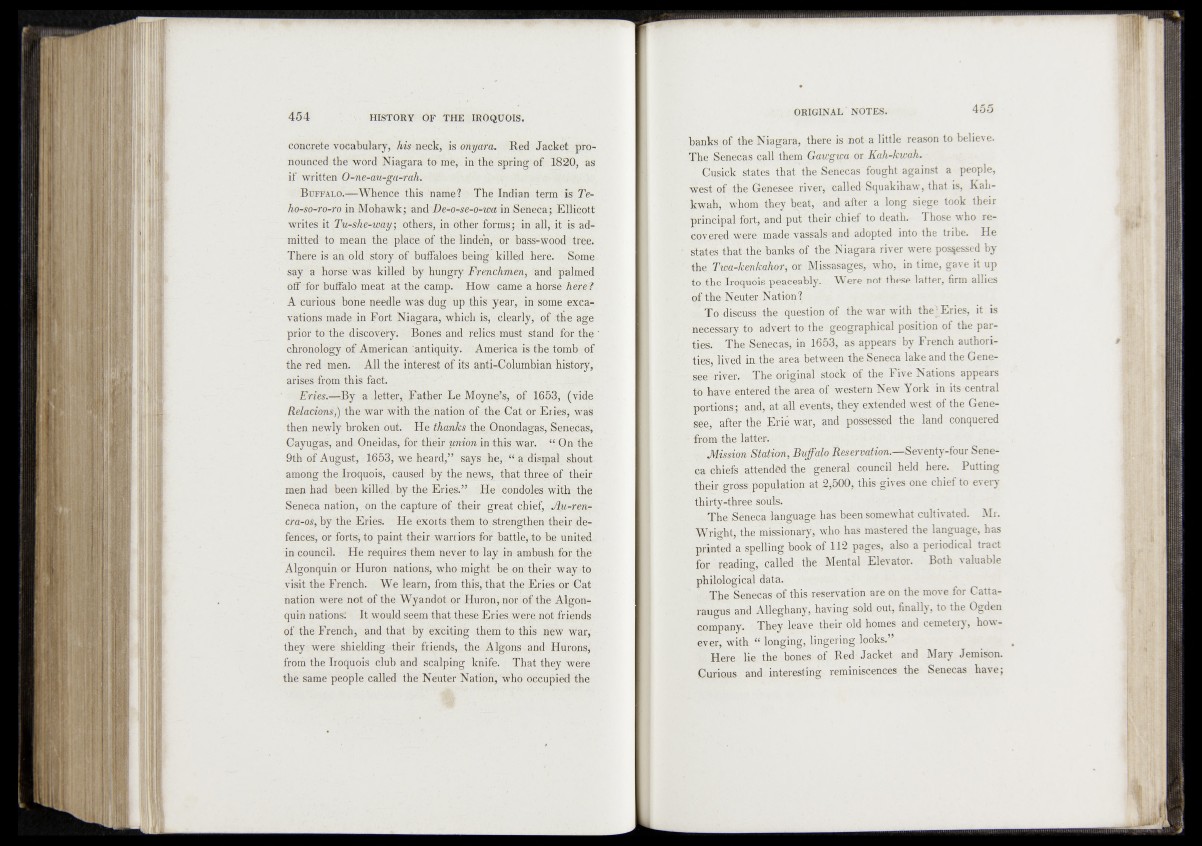
concrete vocabulary, Ms neck, is onyara. Red Jacket pronounced
the word Niagara to me, in the spring of 1820, as
if writtenO-ne-an-ga-rah.
Buffalo,-—Whence this 'name'? : The Indian term is Te-
ho-so-ro-ro in Mohawk; &nd De-*o-?se-o-wa in Seneca; Ellicott
writes it Tu-she-way ; others, in Other forms; in all, it is admitted
to mean the place of the linden, Or bass-wood tree.
There is an old story of buffaloes being killed here. Some
say a horse was killed by hungry Frenchmen, and palmed
off for buffalo meat at the camp. How came a horsè Aere ?
A curious bone needle was dug up this year, in some excavations
made in Fort Niagara, which is,-clearly, of -the age
prior to the discovery: Bones and relics must stand for the
chronology of American 'antiquity. America is thejomb of
the red men. AH the interest of its anti-Columbian history,
arises from this fact.
Eries.—=By a .letter* Rather Le Moyne?s,/of 165.3, ,*(! vide
Relations,) the war with the .nation, pf«the Cat of,Eries, was
then newly broken ouf. K He thanks the Qnondagas, Senecas,
Cayugas, and Oneidas, for. their ymon in this war.L^Qn the
9th of August, 1653, we heard,” says he,; “ 'a dismal shout
among the Iroquois, caused' hy the neWs, that three' of their
men had been killed, by-the Eriçs.” Hp" ©ondoies with the
Senéçâ nation, -oii the capture of their great’chief,, Ay-ren-
era-os, by the Eries. He exoits them to-stoengthen their .defences,
or forts, tp paint their warriors for-battle,-to he united-
in council. • He requires them never to’ lay in ambilsh for the1
Algonquin or Huron nations, who might he on'their way .do
visit the French. We learn, from this, that the Eries or 'Cat
nation were not of the Wyandot or Huron, nor o f the Algonquin
nations! It would-seem that these Eries, were not friends
of the French, and that by exciting them to this pew War,
they. were shielding-4heir friends, the Algons and Hurons;
from the Iroquois club and scalping knife. That they were
the same people called the Nëuter NaÖoöC'wnó OECUpied the
banks of the Niagara, there is not a little reason to believe.
The Senecas call them Guwgwa or Kah-kwah.
Cusick states that the Senecas fought against a people,
west of the Genesee river, called* Squakihaw, that is, Kali-
kwah,. ' whom they beat, and after a long siege took their
principal fort, and put their chief to death. Those who recovered
were made vassals and adopted into the tribe. He
states that-the banks of thé Niagara river were possessed by
the Twa-kehkahor^ or Missasages, who, in time, gave it up
to the Iroquois peaceably. Were not these latter, firm allies
of the Neuter, Nation l : ■
To discuss the question of the war with thelEries, it is
• necessary to advert to the geographical position of the parties.
The Senecas, in 1653, as appears by French authorities,
Jived in. the area between the Seneca lake and the Genesee
river. The original stock of the Five Nations appears
tô hâve entered the area,of western New' York in its central
portions,' and, at all events; they extended west of the Genesee,'
after the Çrié war, and possessed the land conquered
- from the lattér.,
: Mission' Station, Buffalo Reservation.—Seventy-four Seneca
chiefs attended the general council held here. Putting
their gross- population- at; 2*500, this gives one chief to every
thirty-three souls.,
...The Seneca language has been somewhat cultivated. Mr.
Wright,,the missionary*, who has mastered the language, has
printed a spelling, book o f 112 pages, also a periodical tract
for reading, called. the Mental Elevator. Both valuable
philological data.
Xhe Senecas of this reservation are on the move for Cattaraugus
and All,egh.any, having .sold out, finally, to the Ogden
company. ' They leave their old homes and cemetery, however,
with “ longing, lingeringJookSi’?>-;
■ Here lie the bones p f . Red Jacket and Mary Jemison.
Curious and interesting reminiscence the Senecas have;